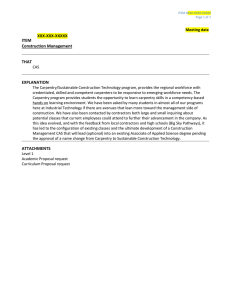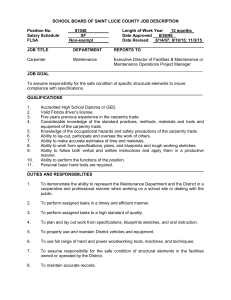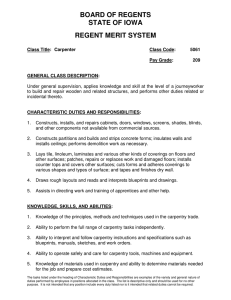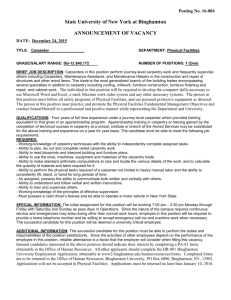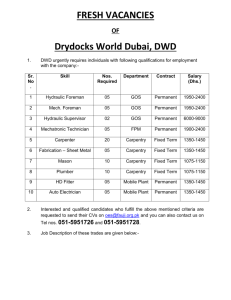Lesson Plan
advertisement
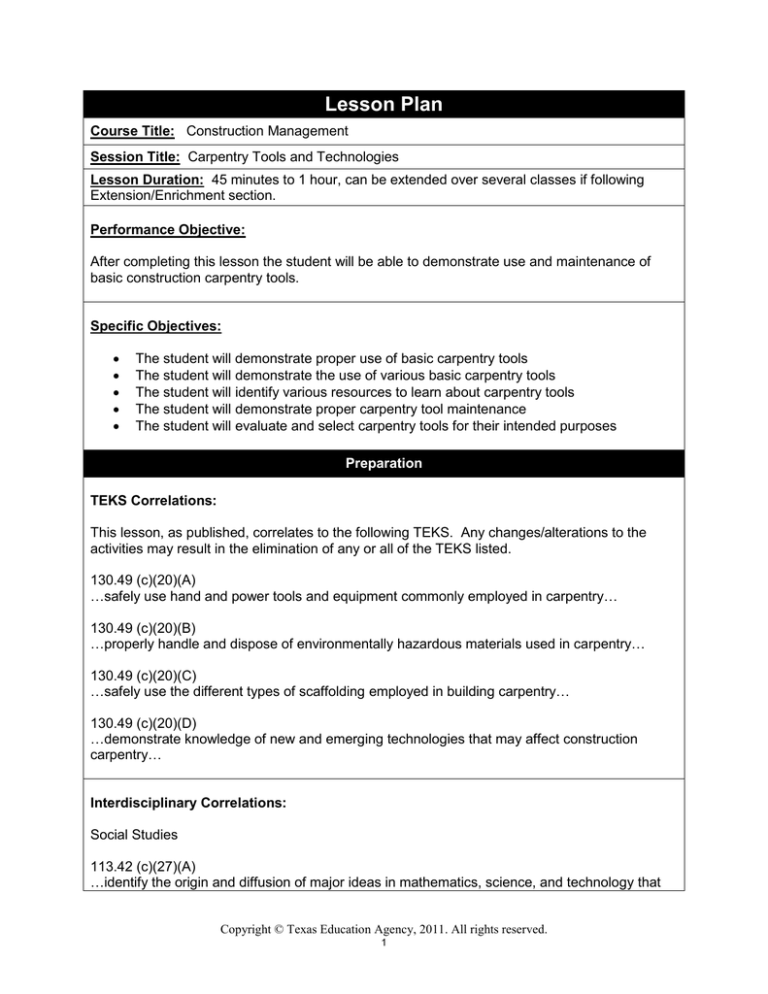
Lesson Plan Course Title: Construction Management Session Title: Carpentry Tools and Technologies Lesson Duration: 45 minutes to 1 hour, can be extended over several classes if following Extension/Enrichment section. Performance Objective: After completing this lesson the student will be able to demonstrate use and maintenance of basic construction carpentry tools. Specific Objectives: The student will demonstrate proper use of basic carpentry tools The student will demonstrate the use of various basic carpentry tools The student will identify various resources to learn about carpentry tools The student will demonstrate proper carpentry tool maintenance The student will evaluate and select carpentry tools for their intended purposes Preparation TEKS Correlations: This lesson, as published, correlates to the following TEKS. Any changes/alterations to the activities may result in the elimination of any or all of the TEKS listed. 130.49 (c)(20)(A) …safely use hand and power tools and equipment commonly employed in carpentry… 130.49 (c)(20)(B) …properly handle and dispose of environmentally hazardous materials used in carpentry… 130.49 (c)(20)(C) …safely use the different types of scaffolding employed in building carpentry… 130.49 (c)(20)(D) …demonstrate knowledge of new and emerging technologies that may affect construction carpentry… Interdisciplinary Correlations: Social Studies 113.42 (c)(27)(A) …identify the origin and diffusion of major ideas in mathematics, science, and technology that Copyright © Texas Education Agency, 2011. All rights reserved. 1 occurred in river valley civilizations, classical Greece and Rome, classical India, and the Islamic caliphates between 700 and 1200 and in China from the Tang to Ming dynasties… 113.42 (c)(27)(B) …summarize the major ideas in astronomy, mathematics, and architectural engineering that developed in the Maya, Inca, and Aztec civilizations… 113.42 (c)(28)(A) …explain the role of textile manufacturing and steam technology in initiating the Industrial Revolution and the role of the factory system and transportation technology in advancing the Industrial Revolution… 113.42 (c)(28)(B) …explain the roles of military technology, transportation technology, communication technology, and medical advancements in initiating and advancing 19th century imperialism… 113.42 (c)(28)(C) …explain the effects of major new military technologies on World War I, World War II, and the Cold War… 113.42 (c)(28)(D) …explain the role of telecommunication technology, computer technology, transportation technology, and medical advancements in developing the modern global economy and society… Occupational Correlations: (reference O-Net http://www.onetonline.org/) 47-1011.00 – First-Line Supervisors of Construction Trades and Extraction Workers – bright outlook Sample of Reported Job Titles: Construction Supervisor, Construction Foreman, Construction Superintendent, Project Manager, Field Supervisor Task: Assign work to employees, based on material or worker requirements of specific jobs (TEKS 130.49.C 31.b, c, e, g, h) Read specifications, such as blueprints, to determine construction requirements or to plan procedures (TEKS 130.49.C 23.a, b, c, d, e, f) Coordinate work activities with other construction project activities (TEKS 130.49.C 17.a, b, c, d) Knowledge: Mechanical — Knowledge of machines and tools, including their designs, uses, repair, and maintenance (TEKS 130.49.C 20.a, b, d) Copyright © Texas Education Agency, 2011. All rights reserved. 2 Design — Knowledge of design techniques, tools, and principles involved in production of precision technical plans, blueprints, drawings, and models (TEKS 130.49.C 23.a, b, c, d, e, f) Mathematics — Knowledge of arithmetic, algebra, geometry, calculus, statistics, and their applications (TEKS 130.49.C 2.b) Engineering and Technology — Knowledge of the practical application of engineering science and technology. This includes applying principles, techniques, procedures, and equipment to the design and production of various goods and services (TEKS 130.49.C 35.a, b, c) Soft Skills: Active Listening, Coordination, Critical Thinking, Speaking, Time Management Teacher Preparation: The purpose of this lesson is to introduce the student to basic carpentry tools used in construction. Depending on the resources of the teacher/classroom, the lesson can be accommodated to that environment. It would be suggested to have actual tool scenarios available for student hands on interaction. Example, have a board with nails to hammer, have screws ready to use with drill, have a level to use on tables, etc. The delivery and direction of this lesson will depend greatly on the resources available to the teacher. Teacher will review the terms in the outline, PowerPoint and handouts to become familiar with lesson. Teacher should be familiar with basic safety rules and purpose of power/hand carpentry tools. Teacher should bring in a variety of carpentry tools for use/observation from the student or find a location that is accessible for students to utilize during lesson delivery. Teacher could secure a carpenter or shop teacher that has resources and deeper knowledge of basic power/hand carpentry tools. References: Early, Joanne. Construction Tools: Pebble Plus, 2008. Print www.careerplanner.com www.guildmc.com www.buildsafe.org www.toolbarn.com Copyright © Texas Education Agency, 2011. All rights reserved. 3 www.stanleytools.com www.johnsonlevel.com www.dewalt.com www.toolup.com http://www.toolsofthetrade.net/ Instructional Aids: 1. Display for PowerPoint, websites, pictures 2. Reference books (if needed) 3. Reference websites (if needed) Materials Needed: 1. Paper 2. Pens, pencils Equipment Needed: 1. 2. 3. 4. Work surface for tools Various power carpentry tools (as needed) Various hand carpentry tools (as needed) Various safety equipment (as needed) Learner Preparation: Discuss rules and guidelines for handling carpentry tools and equipment. Discuss safety features and rules for handling carpentry tools and equipment. Discuss rules and guidelines for computer lab use. Introduction Introduction (LSI Quadrant I): SHOW: Throughout the introduction, show pictures of different carpentry tools, equipment and construction sites. Allow students to ask questions and discuss if they are unclear or curious. ASK: Has anyone ever used tools to build something? Can you give me an example of a tool? SAY: There are all kinds of tools, machines and equipment available to our trade workers today, Copyright © Texas Education Agency, 2011. All rights reserved. 4 especially in the field of carpentry. Screwdrivers, hammers, wrenches, these are all known as hand tools. A drill, rotary saw or planner is known as a power tool. These are all different types of tools used for carpentry and at a construction site. ASK: Do you know the function and purpose of some of these basic carpentry tools? SAY: Each tool has a specific purpose and function. You may wonder why there are many different sizes, lengths, shapes and heads of a screwdriver. They each have a specific function for different purposes. You always want to use the right tool for the job. ASK: Do you know how to select the proper tool? Do you know where to find out? SAY: If you were putting together a birdhouse, you may use a small hammer and nails. But if you were building a storage shed, you might want to use a pneumatic nailer. You would not need to use a full sized pneumatic nailer to build a small birdhouse. The use of a “power” tool on such a small scale project could actually destroy the project rather than build it. Outline Outline (LSI Quadrant II): Instructors can use the PowerPoint presentation, slides, handouts, and note pages in conjunction with the following outline. MI Outline Notes to Instructor I. Cover the concept of carpentry tools in general. Use PowerPoint and websites as aid. II. Cover the evolution of carpentry tools and their uses. Use PowerPoint, websites and carpentry tools as aid. III. Cover the differences of power tools versus hand tools. Use PowerPoint, websites and carpentry tools as aid. IV. Demonstrate the use of certain carpentry tools and their proper safe use. Use PowerPoint, websites and carpentry tools as aid. (Depending on teacher resources, various tools and equipment could be used for demonstration) V. Explain that each student (or group) is to work with This is where the most Copyright © Texas Education Agency, 2011. All rights reserved. 5 the various carpentry tools and demonstrate their functions and purposes. A. Assign teams (if needed) B. Hand out carpentry tools/equipment C. Give time for independent work and exploration D. Refocus class for discussion and findings VI. Discuss with students safety issues, carpentry tool education and the future of carpentry tools. How does the future of materials change the use of carpentry tools? Verbal Linguistic Logical Mathematical Visual Spatial Musical Rhythmic Bodily Kinesthetic Intrapersonal time will be used. Give a definite stop time to allow for discussion and evaluation. Allow students to lead discussions. Point out main points and characteristics of carpentry tools. Interpersonal Naturalist Existentialist Application Guided Practice (LSI Quadrant III): Teacher will demonstrate the use of some basic carpentry tools and/or equipment. Optional: Students can be broken into small teams or groups for this exercise. Independent Practice (LSI Quadrant III): Student will be given time to perform some basic operations with the tools available. This is an excellent time for teacher to observe students and document with camera or other device. This type of documentation is important for displays or reference. Summary Copyright © Texas Education Agency, 2011. All rights reserved. 6 Review (LSI Quadrants I and IV): Question: Have you ever seen or used some of the carpentry tools before? Question: Are there some new carpentry tools that you discovered today? Question: Do you have a better understanding of using the right tool for the job? Question: Do you understand how using the right tool for the job is beneficial and safe? Evaluation Informal Assessment (LSI Quadrant III): Instructor should observe the students’ independent practice time and note the issues or questions that arise. These should be addressed or brought up during summary time. Formal Assessment (LSI Quadrant III, IV): Student/group can receive a grade from direct observation from the teacher. Student/group can be asked to present to class and answer questions about tools. Extension Extension/Enrichment (LSI Quadrant IV): This lesson could be expanded into a longer time frame project. Students could be assigned a specific carpentry tool or type of carpentry tool and have to research its functions and uses. Students can be assigned a longer project with the wrong kind of tool, then given the right carpentry tool and asked to present the difference in ease of use. Students can be asked to research for some new technology in the carpentry tool field. Students can be given a specific carpentry tool and research the history and the changes of the tool. What are its uses or will it be used in the future, etc? Students could be asked to present their ideas of the future and what tools of the future may look like and function. Students could be asked to research current trends and material types, and then predict what the future of tools would look like in the future. Teacher can arrange for a visit from a tool manufacturer/construction worker to bring and talk about tools. Teacher could arrange an actual visit to a construction site or construction company. Copyright © Texas Education Agency, 2011. All rights reserved. 7 Construction Management Carpentry Tools and Technologies Handout Concepts: Tool Selection: understanding that there is the right tool for each and every job. This also leads to proper safety measures and tool effectiveness Vocabulary: Power Tool: is a tool powered by an electric motor, a compressed air motor, battery operated or a gasoline engine. Hand Tool: is a device for performing work on a material or a physical system using only hands Safety: the state of being certain that adverse effects will not be caused by some agent under defined conditions Maintenance: Actions performed to keep some machine or system functioning or in service Copyright © Texas Education Agency, 2011. All rights reserved. 8 Rubric Template Task Statement: __Carpentry Tools and Technologies_______ Task Assignment: _______________________________________ Criteria Concepts/Skills to be Assessed Followed directions Novice 1 Criteria Categories (Novice to Exemplary) Developing Accomplished 2 3 Exemplary 4 (Possible 4 points) No understanding and did not follow directions for lesson Understood and followed some directions for lessons Understood and followed most directions for lesson Understood and followed all directions for lesson Proper handling of tools Did not use tools Improperly handled tools Properly handled tools Accurately handled tools Did not understand the use of tools Understood some of the uses of tools Understood most of the uses of tools Understood the proper use of tools Did not select any tools Improperly selected tools Properly selected tools Accurately and properly selected tools No understanding of tool maintenance Some understanding of tool maintenance Understanding of tool maintenance Accurately demonstrated understanding of tool maintenance (Possible 4 points) Understanding of proper uses of tools (Possible 4 points) Understanding of proper tool selection (Possible 4 points) Understanding of proper tool maintenance (Possible 4 points) A = 20 – 17 points Total Points: 20 B = 16 – 13 points C = 12 – 9 points D = 8 – 5 points F = 4 – 0 points Copyright © Texas Education Agency, 2011. All rights reserved. 9 Points Earned
